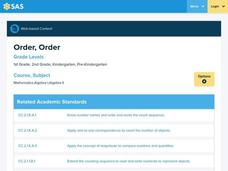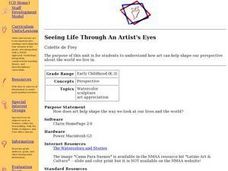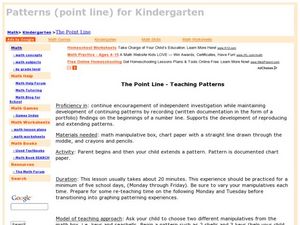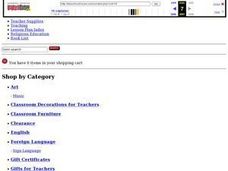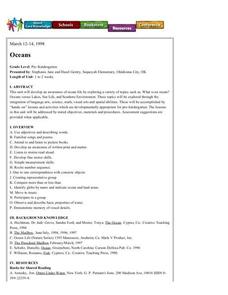Curated OER
The Shape of Things
Learners create shape booklets. In this interdisciplinary instructional activity, students practice shape recognition as they participate in a scavenger hunt and create a shape booklet.
Curated OER
Finding Sums to 6
Students explore the additive identity property where they add multiple numbers to get to the number 6. In this number 6 lesson plan, students also work on their addition charts.
Curated OER
Shirts Full of Buttons
Learners match sets of buttons to complete subtraction problems. In this subtraction lesson plan, students answer the questions "how many more/less" and make bar graphs by counting up the buttons they are wearing.
Curated OER
Balancing
Students use a balance to complete subtraction problems and weigh out the items they take away. In this subtraction lesson plan, students use a pan balance and record their equations.
Pennsylvania Department of Education
Order, Order
Students use pictures to identify items as ordinal numbers. In this ordinal numbers lesson plan, students use the words "before" and "after" to identify the pictures as well.
Curated OER
Balancing Discoveries
Learners use a balance to help them with their addition facts. In this addition lesson plan, students also play the seven up game to memorize their facts.
Pennsylvania Department of Education
How Many Ways?
Students estimate the amount of money they have in groups of pennies, nickels, and dimes. In this money lesson plan, students then count up the amounts they have and exchange money amounts.
Curated OER
Bug Hunt
Students strengthen observational skills by searching for insects in their home and classroom. In this observation lesson, students use magnifying glasses to classify what kinds of bugs were found. Students then create a bar graph to...
Curated OER
Counting Fun with Gummi Bears
Students count the numbers one through ten out loud and show the numbers using manipulatives.
Curated OER
Philanthropic Literature: Give a cookie
Students read a book to discover the importance of sharing. They predict what will happen in the story. Students use manipulatives to model the story problem. Students follow instructions, measure ingredients, and make cookies.
Curated OER
Seeing Life Through An Artist's Eyes
Young scholars examine how art can change the way they look at their lives. After being read a book, they discuss the importance of art in their world and what would happen if it were taken away. They create a watercolor painting and...
Curated OER
The Flat Stanley Project
Students read the book Flat Stanley. In this environmental stewardship instructional activity, students participate in earth-friendly activities based upon the book. This instructional activity includes ideas such as using recycled...
Curated OER
Lesson Plan #26
Students build background knowledge or schema of critical division skills by predicting or inferring what will happen next in the story, retelling story detail, and counting the number of cookies on the plate.
Curated OER
The Point Line - Teaching Patterns
Pupils practice extending patterns. In this patterns lesson, students demonstrate extending patterns by performing a rhythmic patter.
Curated OER
And the Number Is
Students identify the numbers 1-10 while listening to a counting song. They practice counting items using the numbers 1-10.
Curated OER
Graphs
Students listen to the book, TOPS AND BOTTOMS looking at different vegetables from the story that they have tried in class that week.
They then focus their attention on a graph called, "What is Your Favorite Vegetable?". They place a...
Curated OER
Venn Diagram
Students use a Venn diagram to show students' likes and dislikes of eggs and ham.
Curated OER
Sorting Lids
Young scholars practice sorting lids in different ways so that each group determines a sorting pattern. They examine how to work in groups while sharing ideas. They establish group work relationships that become apparent to the teacher...
Pennsylvania Department of Education
Seeing Doubles
Students work with dominoes to recognize the number of spots on each side as they relate to addition facts. For this seeing doubles lesson, students make triangle shaped flash cards for the double facts. Students represent the correct...
Pennsylvania Department of Education
Multiple Patterns
Young scholars explore patterns that involve doubling numbers. In this multiple patterns lesson, students use objects to explore these patterns while recording them using a table. Young scholars recognize even and odd number patterns...
Curated OER
Build Your Own Bug
Students create a unique bug. In this lesson about bugs, students use their imagination to develop a new kind of bug. Students use construction paper, scissors, glue, and crayons to make their bug. Students explore the different parts of...
Curated OER
How Does Your KinderGarden Grow
Learners find forecast and graph weather by using WeatherBug site, create flower books by using Wiggleworks, and plant radish seeds both on KidPix and in class garden.
Curated OER
Oceans
Students become aware of the differences between ocean water and lake water by smelling, tasting and seeing. They distinguish between land and bodies of water on a globe and gain increased awareness of oceans and life.






